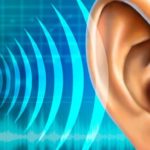Sound is produced due to the mechanical vibration of the media. Sound waves propagate as longitudinal (compression/rarefactions) waves in gases, liquids, and solids. To hear a sound, the energy source should be capable of creating compression waves in the media. This waves upon falling on the diaphragm of the ear will vibrate it enabling the brain to perceive it as sound.
In AC 50Hz system, the electrons in the media oscillates at a frequency 50Hz inside the conductor. So it is not the media(molecules) that is undergoing vibration but the electrons. The electrons collide with the molecules and bounce randomly while oscillating. This will be converted as heat/light energy ( as in filament bulbs, heating coils) but not as mechanical vibrations. So we cannot hear the oscillating electrons.
Hearing involves the vibration of a mechanical media in the frequency range that mentioned. Even though alternating current has a frequency (50Hz), it may or may not have anything to do with mechanical oscillation. However, if the circuit is such that the alternating current generates vibration (as in the case of the speaker), then you can hear the mechanical vibration, otherwise, we cannot.
In the case of sound, frequency means no. of vibrations of an oscillating particle per second. You can find the equation of progressive waves(which sound is in fact) as below:
y= A sin 2πft, Here f= Frequency ,
Now comes about frequency concerning electricity. It is a concept of a.c current in fact which refers how many times electricity is changing its direction per second. you can find the term in the following equation:
E= E’ sin 2πft , Here f= Frequency ,
Now, in both the cases we find frequency as a valid term but in different definitions and in different forms too. so their role is not the same. again, sound is produced by vibration in the particles of a medium where electricity is produced due to the flow of electron. So, until there is no vibration in a medium we can’t hear sound.
Adding, electricity does not follow wave properties where you know that sound is a form of power that is beared by waves. Also we can say, sound is a form of power that awakens the power of hearing in our brains. But electricity is not capable of that.
Also frequency used in other terms(light, simple harmonis oscilation) can’t make us feel hearing that until it is turned into sound or in other words, until it vibrates the air particles around us.
Now come to the second part of the answer to the question called Discussion:
- Some people say that we can be able to hear electricity. But we cannot because all the electrical copper wires are covered with plastic insulation. So, Apart from providing electrical insulation, it also serves as insulation to sound. As a result of which the vibrations are unable to leave the interiors of the insulation.
For them I want to ask one question, i.e If we cut a small part of the plastic insulation around the wire and bringing that wire near to ear (considering precautions), then can we hear the current sound? and a big no for that illustration. - The second doubt that encountered is “We can hear Zzzzz sound near the large transformer, where that sound is coming from ?”
yeah, that all happening because there is some magnetic induction to the metal casing in the transformer.
Source: https://qr.ae/pN2Mrq
Terms of Service: https://www.quora.com/about/tos


optimal article